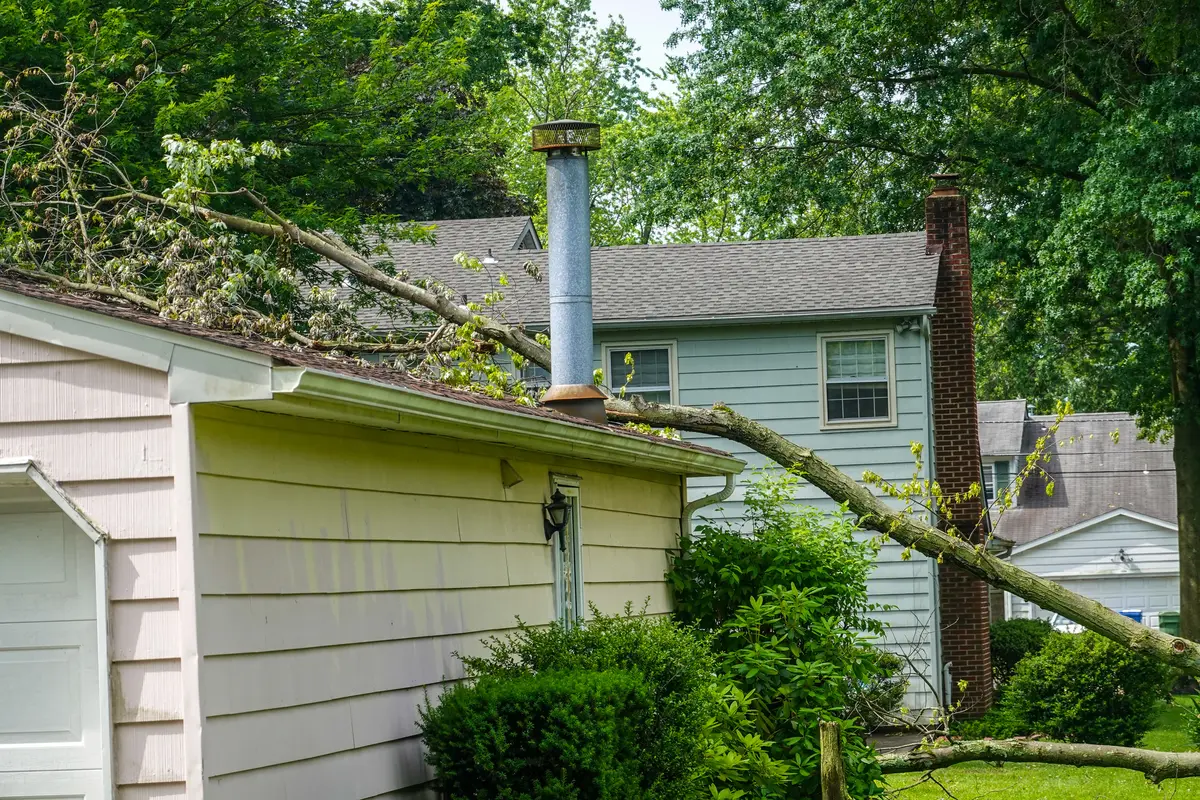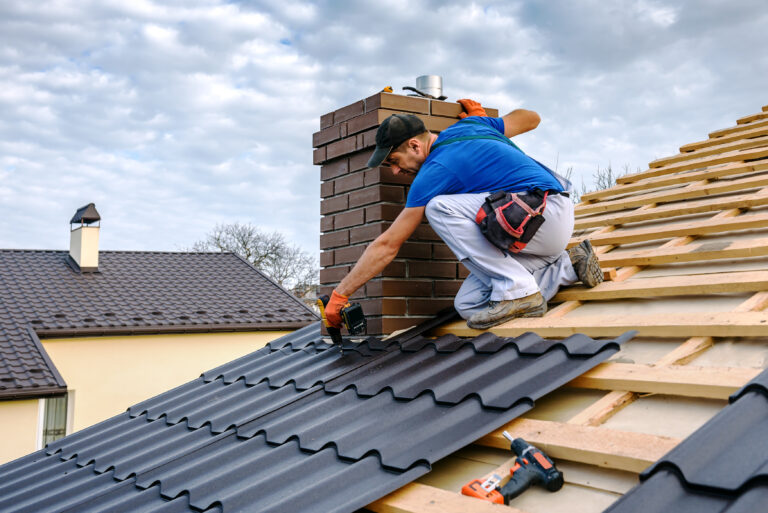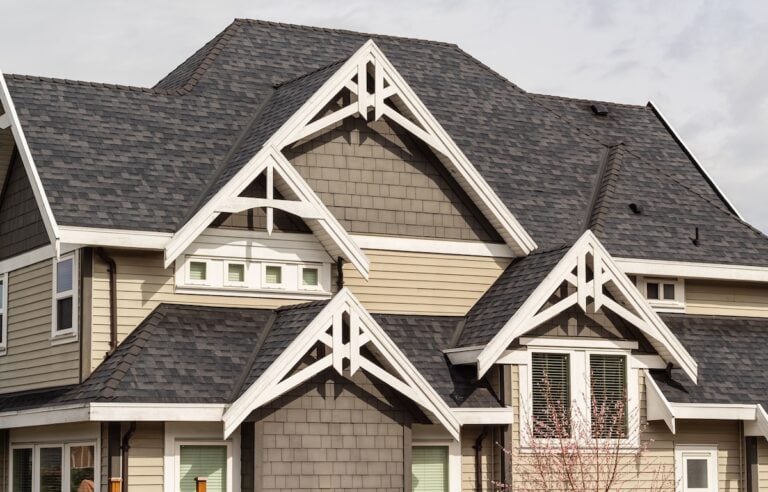Roofs are not immune to damage, even if they’re strong and durable. But what do you do when your roof IS damaged?
Understanding the various types of roof damage can help homeowner:
- Identify issues early
- Perform timely maintenance
- Avoid costly repairs
In today’s guide, we’ll explore the most common types of roof damage, their causes, and how to address them effectively.
10 Types of Roof Damage
Before you can repair roof damage, it’s essential to understanding the different types of roof damage, and what they mean for your roofing system.
1. Wind Damage 💨
Windstorms can wreak havoc on a roof, especially if it’s older or already compromised. Strong winds can lift and tear shingles, exposing the underlayment and decking to the elements.
Causes:
- High Winds: Gusts exceeding 60 mph can cause significant damage to shingles.
- Falling Debris: Tree branches and other debris carried by the wind can puncture and dent roofing materials.
Signs:
- Missing Shingles: Look for bald spots where shingles have been ripped off.
- Creased or Curled Shingles: These indicate that the wind has lifted the shingles, weakening their attachment.
- Chimney Flashing Damage: High winds can loosen or remove flashing around chimneys, leading to leaks.
Solutions:
- Regular Inspection: After a windstorm, check your roof for missing or damaged shingles.
- Reinforce Vulnerable Areas: Secure loose shingles and flashing to prevent wind from getting underneath them.
- Trimming Trees: Keep trees trimmed to minimize the risk of falling branches.
2. Hail Damage 🧊
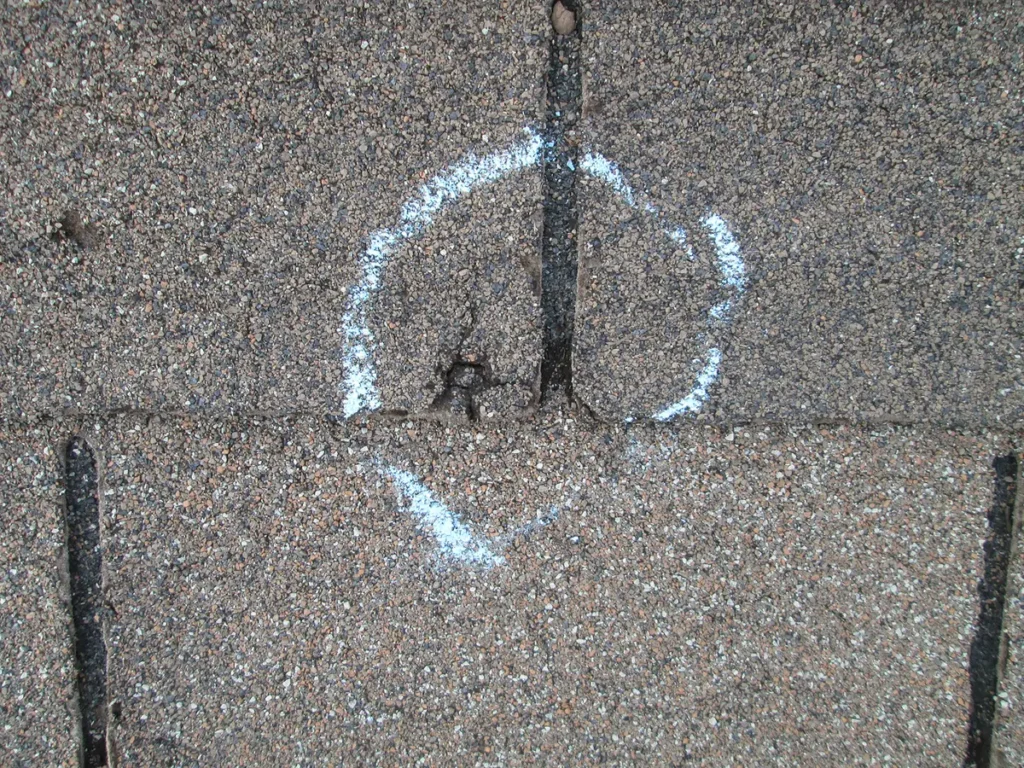
Hailstones vary in size but can cause severe damage to roofs by denting, cracking, or puncturing shingles and other roofing materials.
Causes:
- Hailstorms: Hailstones can range from pea-sized to golf ball-sized and fall at high speeds.
Signs:
- Dented Shingles: Look for pockmarks or bruises on shingles.
- Granule Loss: Excessive granules in gutters can indicate hail damage.
- Cracked Shingles: Large hailstones can crack or puncture shingles, leading to leaks.
Solutions:
- Inspection Post-Storm: After a hailstorm, have a professional inspect your roof for damage.
- Repair or Replace Damaged Shingles: Address damaged areas promptly to avoid further deterioration.
- Consider Impact-Resistant Shingles: These shingles are designed to withstand the impact of hailstones.
3. Water Damage 💧
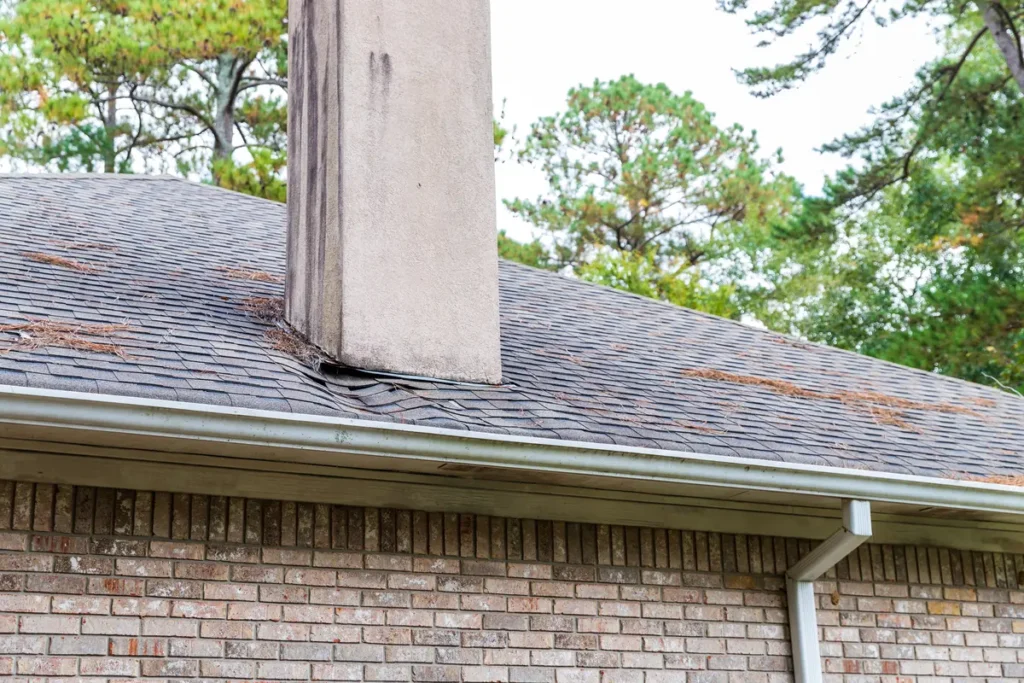
Water damage is a significant concern for homeowners as it can lead to mold growth, structural issues, and interior damage.
Causes:
- Leaking Roof: Commonly caused by damaged shingles, flashing, or underlayment.
- Ice Dams: These form when snow on the roof melts and refreezes at the eaves, causing water to back up under the shingles.
- Clogged Gutters: Prevent proper drainage, leading to water pooling on the roof.
Signs:
- Water Stains on Ceilings: Often the first visible sign of a roof leak.
- Mold Growth: Indicates persistent moisture problems.
- Sagging Roof Deck: A clear indication of severe water damage.
Solutions:
- Regular Maintenance: Clean gutters and downspouts to ensure proper drainage.
- Address Leaks Promptly: Repair any leaks as soon as they are detected.
- Install Ice and Water Shield: This underlayment provides additional protection against water infiltration.
4. Sun Damage 🌤️
Prolonged exposure to the sun’s UV rays can degrade roofing materials over time, leading to a shorter lifespan and increased vulnerability.
Causes:
- UV Radiation: Breaks down roofing materials, causing them to become brittle and crack.
- Thermal Cycling: The daily expansion and contraction of roofing materials due to temperature changes.
Signs:
- Faded Shingles: Sunlight can cause shingles to lose their color.
- Brittle Shingles: Shingles that easily crack or break when touched.
- Cracked or Splitting Shingles: Caused by prolonged exposure to heat.
Solutions:
- Use UV-Resistant Shingles: These shingles are designed to withstand the effects of UV radiation.
- Regular Inspections: Identify and replace damaged shingles promptly.
- Reflective Coatings: Applying a reflective coating can reduce the amount of UV radiation that penetrates the shingles.
5. Tree Damage 🌳
Trees can be both aesthetically pleasing and damaging to roofs. Overhanging branches pose a risk of falling or scraping against the roof surface.
Causes:
- Falling Branches: Heavy branches can break off during storms and fall on the roof.
- Overhanging Limbs: Constantly rubbing against shingles, causing wear and tear.
- Leaf Accumulation: Leaves can accumulate in gutters and valleys, leading to water damage.
Signs:
- Broken or Missing Shingles: Resulting from falling branches.
- Scratches and Gouges: Indicating branches are rubbing against the roof.
- Blocked Gutters: Overflowing gutters due to leaf accumulation.
Solutions:
- Tree Trimming: Regularly trim branches that overhang the roof.
- Remove Dead or Diseased Trees: To prevent them from falling on the roof.
- Install Gutter Guards: To prevent leaves from clogging gutters.
6. Poor Installation ⚒️
Even the best materials can fail if not installed correctly. Poor installation practices can lead to various issues, causing premature roof failure.
Causes:
- Improper Nailing: Shingles not nailed correctly can easily be blown off.
- Incorrect Flashing Installation: Can lead to water infiltration.
- Inadequate Ventilation: Can cause moisture buildup and damage.
Signs:
- Loose or Missing Shingles: Due to improper nailing.
- Leaks Around Flashing: Indicating poor installation.
- Mold and Mildew: Resulting from inadequate ventilation.
Solutions:
- Hire Qualified Professionals: Ensure your roof is installed by experienced and certified contractors.
- Regular Inspections: Identify and correct installation issues early.
- Proper Ventilation: Ensure adequate ventilation to prevent moisture buildup.
7. Animal Damage 🦝
Animals such as squirrels, raccoons, and birds can cause significant damage to roofs in their quest for shelter or food.
Causes:
- Nesting: Birds and rodents can nest in attics, damaging insulation and wiring.
- Chewing: Squirrels and raccoons can chew through shingles and wood.
- Droppings: Animal droppings can corrode roofing materials.
Signs:
- Holes in the Roof: Indicating animals have chewed through.
- Nesting Materials: Found in gutters or attics.
- Unusual Noises: Scratching or scampering sounds in the attic.
Solutions:
- Animal Proofing: Seal entry points and use deterrents to keep animals away.
- Trim Trees and Bushes: Remove easy access points for animals.
- Regular Inspections: Check for signs of animal activity and address promptly.
8. Snow and Ice Damage ❄️
During winter, snow and ice can cause various types of damage to roofs, particularly in regions with heavy snowfall.
Causes:
- Heavy Snow Loads: Can cause structural damage or collapse.
- Ice Dams: Form when snow melts and refreezes at the roof’s edge, leading to water backup.
- Freeze-Thaw Cycles: Cause expansion and contraction, leading to cracks.
Signs:
- Sagging Roof: Indicates the roof is bearing too much weight.
- Water Leaks: Resulting from ice dams.
- Cracked Shingles: From freeze-thaw cycles.
Solutions:
- Snow Removal: Safely remove excess snow from the roof.
- Ice Dam Prevention: Use heating cables or ensure proper attic insulation.
- Roof Inspections: Check for damage after winter storms.
9. Age-Related Damage 👴🏼
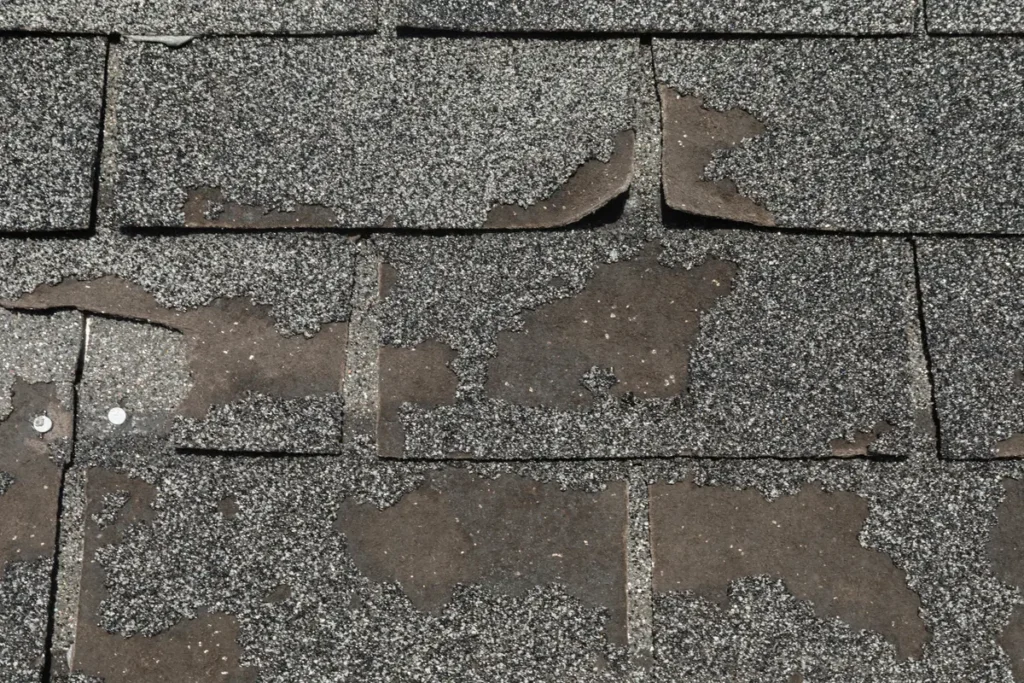
No matter how well-maintained, roofs will eventually show signs of aging. Understanding these signs can help homeowners plan for repair or replacement.
Causes:
- Natural Wear and Tear: Over time, exposure to the elements will degrade roofing materials.
- Material Lifespan: Different roofing materials have varying lifespans.
Signs:
- Bald Spots: Where granules are missing from shingles.
- Curling or Buckling Shingles: Indicating the end of their useful life.
- Frequent Leaks: A sign that the roof may need replacement.
Solutions:
- Regular Maintenance: Keep up with regular inspections and minor repairs.
- Plan for Replacement: Know the typical lifespan of your roofing material and budget for replacement before significant issues arise.
- Upgrade Materials: Consider longer-lasting materials when replacing your roof.
10. Structural Damage 🏚️
Structural damage to a roof can be severe and often results from a combination of factors, including weather events, poor installation, and neglect.
Causes:
- Severe Weather: Hurricanes, tornadoes, and earthquakes.
- Neglect: Failing to address minor issues can lead to significant structural problems.
- Poor Construction: Using substandard materials or practices.
Signs:
- Sagging Roof: A clear sign of structural issues.
- Cracked or Split Rafters: Visible in the attic.
- Gaps in the Roof Decking: Indicating movement or settlement.
Solutions:
- Professional Assessment: Have a structural engineer assess the damage.
- Timely Repairs: Address issues promptly to prevent further damage.
- Quality Construction: Ensure any structural repairs or replacements use high-quality materials and craftsmanship.
Roof Replacement or Repairs? Palladium Has You Covered
Understanding the various types of roof damage and their causes is crucial for maintaining the integrity of your home. Regular inspections and timely maintenance can prevent minor issues from becoming major problems, saving homeowners time and money in the long run. If you suspect any damage to your roof, it’s essential to consult a professional for a thorough inspection and appropriate repairs.
Remember, a well-maintained roof not only protects your home but also adds to its overall value and curb appeal. Stay proactive and keep your roof in top condition to ensure it continues to provide the protection and comfort your family deserves.
Contact Palladium Roofing today to schedule your professional roof repairs!


